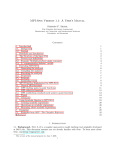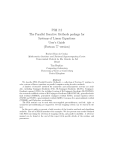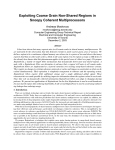Download Integrated Parallel Macros User's Guide
Transcript
Integrated Parallel Macros
User's Guide
Luc Giraud, Pascale Noyret,
Eric Sevault, Vincent Van Kemenade
January 1995
TR/PA/95/01
IPM 2.3
User's Guide
and Reference Manual
January 1995
I
ntegrated
english:
Parallel Macros
french:
nutile Paquet de Macros
I
Abstract
This user's guide describes the features of the set of m4 macros provided by
IPM (Integrated Paralell Macros). Those macros allow the users to easily implement a portable distributed programme based on the message passing paradigm
using a hidden message passing library like PVM, PARMACS or a subset of MPI.
The choice of the hidden message passing library is made only at the compilaton
time.
The purpose of this set of macros is not to provide the user with a new message
passing library (IPM is not even a library) but only to provide the user with
a simple message passing interface. Some IPM macros give an easy access to
relevant message passing data, while avoiding a deep technical knowledge of the
hidden message passing library.
We made the choice of a set of macros (although the drawback of some possible
border eects) instead of a library, mainly because it allows the advanced users
to have access to the expanded code for tuning some communication according to
his knowledge of both the target architecture and the \hidden" message passing
library.
L. Giraud, P. Noyret, E. Sevault, V. Van Kemenade
- CERFACS -
42 avenue Coriolis, 31 057 TOULOUSE cedex
2
IPM 2.3
Contents
Acknowledgements
1 Introduction
2 Conventions
2.1
2.2
2.3
2.4
IPM Programming Models
Process Identier
Logical Topologies
Communications
4
5
5
: : : : : : : : : : : : : : : : : : : : : : : : :
: : : : : : : : : : : : : : : : : : : : : : : : : : : : : :
: : : : : : : : : : : : : : : : : : : : : : : : : : : : :
: : : : : : : : : : : : : : : : : : : : : : : : : : : : : :
3 Obtaining IPM
4 Compiling IPM Applications
5 User Interface
5.1 Naming Conventions
5.2 Behavior of Macros Calls
5.3 List of Macros
5
6
6
6
7
7
8
: : : : : : : : : : : : : : : : : : : : : : : : : : : :
: : : : : : : : : : : : : : : : : : : : : : : : : :
: : : : : : : : : : : : : : : : : : : : : : : : : : : : : : : :
6 Advanced Features
6.1 Data{types
6.2 Encoding ag in ipm.h.pvm
6.3 Internal integer type in ipm.h.pvm
11
: : : : : : : : : : : : : : : : : : : : : : : : : : : : : : : : :
: : : : : : : : : : : : : : : : : : : : : : : :
7 Warnings and Bugs
Reference pages for IPM 2.3 macros
An example of generic makele
8
8
8
: : : : : : : : : : : : : : : : : : : :
11
11
11
12
13
55
3
IPM 2.3
Acknowledgements
Some important contributions to the denition and the continuing development of IPM
have come from researchers who do not formally belong to the \FunParTools Corporation". We would like to thank the following persons for their help and suggestions:
Norman Barth (UCSD)
Frederic Carbonnell (CERFACS)
Tuomo Kauranne (University of Joensuu-Finland)
Jean Latour (CRAY FRANCE)
Michael Rudgyard (CERFACS)
Sami Saarinen (CSC-Finland)
Philip Hariss (FEGS-Cambridge)
4
IPM 2.3
1. Introduction
This guide contains a brief overview of the information required to implement parallel
code using message passing with IPM 2.3. A dominant characteristic of the \Integrated
Parallel Macros" is that they are \integrated" macros, and are therefore easy to use
(at least, in our opinion !!). The user may then avoid many of the technical aspects of
the parallel implementation and concentrate on the application itself.
IPM is not a new message passing library. Not even a library. It is just a package
of m41 macros built on top of existing message passing libraries such as PVM2 3.2.x
or 3.3.x or PARMACS3 6.0. It allows the user to choose between parallel libraries
at compilation time although he retains a single source code { it therefore reduces
development costs while permitting the use of libraries that may be better suited for
a particular hardware conguration. New releases of these libraries are hidden from
the user because of the compact IPM interface. For advanced features, the user can
easily alter parts of the macros or modify the expanded source code before compilation.
IPM has been designed keeping in mind the specications for MPI. Converting applications from IPM to MPI should not be dicult | indeed, this will not be necessary
as soon as an IPM interface to MPI is available. An MPI subset, built on top of IPM
calls, is provided with the IPM package.
2. Conventions
2.1. IPM Programming Models
IPM supports both Host-Node and SPMD programming models:
For a Host-Node scheme, the user can explicitly dene the environment through
the IPM BEGIN HOST or the IPM BEGIN NODE calls. All others macros can
be invoked from the host or node program.
The nodes are created using the IPM CREATE TORUS or IPM CREATE GRAPH
macros, which dene a logical topology for node processes. In many cases, the
host may be excluded from this logical topology and therefore does not participate in the computational part of the execution. Note that the IPM BARRIER
macro provides the user with a barrier that synchronizes all the node processes.
With the SPMD model, each process runs the same program. Since IPM is built
on top of parallel libraries where one process is in charge of the creation of the
others, there is always a \host" process, even if this is hidden from the user. As a
result, the work to be performed in some macros is only dened at execution time.
1
2
3
m4 is the standard Unix macro language processor.
Geist et al. Oak Ridge National Laboratory.
Hempel et al. Institute fur Methodische Grundlagen and GMD
5
IPM 2.3
For example, the IPM INIT macro performs functions of IPM BEGIN HOST
or IPM BEGIN NODE depending on the nature (\host/node") of the calling
process. For the same reason, the IPM CREATE instructions are ignored when
running on a \node" process. The \host" process is supposed to be a formal
member of the logical topology and has an eective part of the computational
work. The IPM GBARRIER synchronizes both \host" and \node" processes.
2.2. Process Identier
All the processes are identied by an integer rank, starting from 0 up to size-1, where
size is the total number of processes. In most cases, one can distinguish host process
with rank 0 and node processes with ranks from 1 up to number of nodes. These logical
values are the only ones recognized by IPM. The underlying task identiers (tid PVM)
or process identiers (pid PARMACS) are no longer required and are completely hidden
from the user.
2.3. Logical Topologies
As well as MPI and PARMACS, IPM provides two main topologies: a torus of up
to four dimension and a customized graph. As these features are not available with
PVM, they are completely emulated by IPM. A binary tree is also provided for global
reduction or scatter operations across the nodes.
2.4. Communications
Processes exchange data through tagged messages. IPM provides asynchronous send,
and blocking or non-blocking receive functions, as well as multi-cast and probe functions. These communication routines allow the user to communicate contiguous data
in the memory: no packing is assumed and the user may need to dene intermediate
\buer" arrays before using these functions. A message is dened by its datatype and
the number of elements sent or received (previous releases of IPM only needed the
length in bytes). Processes ranks are used to specify the destination or the origin of
messages.
6
IPM 2.3
3. Obtaining IPM
The IPM package is available by anonymous ftp from orion.cerfacs.fr (138.63.200.33)
on /pub/algo/softw/ipm. The le is available in a tar compressed (or gzipped) format
\ipm.tar.Z" (or ipm.tar.gz). After an uncompress and a tar xvf ipm.tar, one can retrieve the following directory:
ipm
Readme
doc
ipmdoc.ps
example
gridsum
makefile
sum.F
ring
makefile
host.F
node.F
spmd.F
include
dico
ipm.h.pm6
ipm.h.pvm
mpi
Readme
makefile
mpif.h
mpiipm.F
The le ipm/include/dico contains the list of all the macros dened in the include les.
The mpi directory contains a subset of MPI functions built on top of IPM. See the
Readme le of this directory for more information.
4. Compiling IPM Applications
Before compiling an application written with IPM, the user has to select an available
parallel library for the target machine. A symbolic link must then be dened between
the local ipm.h le and the corresponding IPM include le. For example, if the library
to be used is PVM, the following link should be created :
ln -s $HOME/ipm/include/ipm.h.pvm ipm.h
The user should also link with the specic include les of the chosen library such as
\fpvm3.h" (PVM) or \pm.inc" (PARMACS 6.0). Files with IPM calls must contain
one (and only one) m4 include instruction at the beginning of the le:
include(ipm.h)
c
subroutine subvoid
c
...fortran code...
7
IPM 2.3
These les should be expanded before compilation using the m4 pre-processor in the
makele (an example of a generic makele using IPM is given in appendix II):
.F.o:
m4 $*.F | egrep -v '#' > $*.f
$(F77) $(OPTIONS) -c $*.f
5. User Interface
5.1. Naming Conventions
All of the macros start with \IPM " prex and are written in upper case letters. No
blanks or carriage returns are permitted in the macro interface:
c
c
c
correct:
IPM_GET_RANK(coords,rank)
incorrect:
IPM_GET_RANK ( coords, rank )
IPM_GET_RANK(coords,
*
rank)
5.2. Behavior of Macros Calls
Some macros behave like subroutine calls and others as functions calls. For example,
IPM_GET_RANK(coords,rank)
behaves as a subroutine call, where rank is an \output" argument of the subroutine,
and
neigh = IPM_RANK + 1
behaves as a function call. Note that there is no overhead when functions such as
IPM RANK are called several times, and it would be against IPM's philosophy to
store this value elsewhere.
5.3. List of Macros
Process management
IPM ABORT
IPM BARRIER
IPM BEGIN HOST
IPM BEGIN NODE
IPM DECLAR
IPM END
8
IPM 2.3
IPM INIT
IPM GBARRIER
Logical topology
IPM CREATE GRAPH
IPM CREATE TORUS
Communication features
IPM MCAST
IPM NRECV
IPM PROBE
IPM RECV
IPM SEND
Global tree
IPM DADDY
IPM MAXSONS
IPM NB SONS
IPM ROOT
IPM SONS
Inquiry functions
IPM GET ALL COORDS
IPM GET COORDS
IPM GET RANK
IPM HOST
IPM HOST STATUS
IPM LIBRARY
IPM MSG RECV
IPM MSG SEND
IPM NBRECV
9
IPM 2.3
IPM NBSEND
IPM NB NEIGHBORS
IPM NEIGHBORS
IPM NODES
IPM RANK
IPM SIZE
IPM TOPO
IPM TORDIM
IPM TORSIZE
IPM TYPE LENGH
IPM VERSION
Dened Constants
IPM ANYSND
IPM ANYTAG
IPM GRAPH
IPM HOST I
IPM HOST 0
IPM NO DADDY
IPM NONE
IPM PARMACS
IPM PVM
IPM TORUS
Generic Data{types
IPM COMPLEX
IPM DBLE
IPM INTEGER
IPM REAL
Specic Data{types
IPM BYTE
IPM CHARACTER
10
IPM 2.3
IPM COMPLEX8
IPM COMPLEX16
IPM INT2
IPM INT4
IPM INT8
IPM REAL4
IPM REAL8
We refer to the appendix for a complete description of those macros.
6. Advanced Features
6.1. Data{types
In order to run on computers with dierent intrinsic data representation types, one
can edit the ipm.h le and modify the generic data types:
# for 4-bytes reals (Sun4s, IBM RS6000s, ...): IEEE arithmetic.
define(IPM_REAL,REAL4)
# for 8-bytes reals (Crays)
#define(IPM_REAL,REAL8)
The sources of the application itself need not be changed if generic data types are used
in communication macros.
6.2. Encoding ag in ipm.h.pvm
The PVM encoding scheme when initializing send buers is dened in an internal
macro of the ipm.h.pvm le, which may be edited and modied:
# Initsend Buffer Flag ( Customized )
# -------- ------ ---#
define(IPM_INITFLAG,PVMRAW)
The PVMINPLACE option is not available with PVM 3.2.
6.3. Internal integer type in ipm.h.pvm
IPM uses and exchanges integers to store process identiers, current topology, trees
information...etc. In order to keep a maximum of exibility, no specic type had been
dened for these integers. An integer is then dened by two IPM internal macros: an
internal type and the number of internals needed to constitute an integer. The default
values are:
11
IPM 2.3
# Internal Integer Type and Basic unit ( Customized )
# -------- ------- ---- --- ---------#
define(IPM_INTERNAL,INTEGER4)
define(IPM_INTBUNIT,1)
which denes the internal integer used by IPM to be a single INTEGER4. If the user
wishes to run on a CRAY T3D, or other machines where 8 bytes integers are default,
he should dene:
define(IPM_INTERNAL,BYTE1)
define(IPM_INTBUNIT,8)
7. Warnings and Bugs
A customized graph which includes the host process as an active process is not possible
using PARMACS 6.0. The only way of running such an application is to dene an underlying one-dimensional torus with PARMACS and then to emulate the customized
graph.
If the current mapping is a torus and the host process is not included in this topology,
then calling IPM GET COORDS with the host process' rank returns the point of origin. However, IPM GET RANK with the same coordinates returns 1, which is clearly
not the rank of the host process.
It happens on the Meiko CS-2 machine that an executable is unable to spwan itself.
No denitive reason has been found for this problem. A solution is to duplicate the
executable.
The user should not use message tags greater than 16000000.
12
IPM 2.3
Appendix I:
Reference pages for IPM 2.3 macros
13
IPM 2.3
IPM ABORT
subroutine
Synopsis
IPM ABORT
Arguments
In
none
Out
none
Discussion
The IPM ABORT macro kills all existing processes except itself and exits from
the parallel application. The calling process is not killed.
Example
c
c*
c
Check for incorrect value of IPM_RANK
if ( IPM_RANK.lt.0 ) then
IPM_ABORT
stop
endif
14
IPM 2.3
IPM ANYSND
constant
Synopsis
IPM ANYSND
Arguments
In
none
Out
none
Discussion
Using IPM ANYSND in place of the sender's rank in receive and probe functions
matches any process rank.
Example
c
c*
c
Check if a specified tagged message has arrived
integer msgtag, is, it, arrived
c
msgtag = 101
IPM_PROBE(IPM_ANYSND,msgtag,is,it,arrived)
15
IPM 2.3
IPM ANYTAG
constant
Synopsis
IPM ANYTAG
Arguments
In
none
Out
none
Discussion
Using IPM ANYTAG in place of the tag argument in receive and probe functions
matches any tag number.
Example
c
c*
c
Check if any kind of message has arrived
integer is, it, arrived
c
IPM_PROBE(IPM_ANYSND,IPM_ANYTAG,is,it,arrived)
16
IPM 2.3
IPM BARRIER
subroutine
Synopsis
IPM BARRIER(bartag)
Arguments
In
bartag - integer barrier identier supplied by the user. Should be
in the same range than message tag. It allows the user
to distinguish between two barriers.
Out
none
Discussion
IPM BARRIER synchronizes all the node processes. If called from the host
program, the barrier call is ignored. Node processes have to use the same barrier
identier, otherwise a deadlock will occur.
See also IPM GBARRIER.
Example
c
c*
c
c*
first barrier
IPM_BARRIER(101)
second barrier
IPM_BARRIER(102)
17
IPM 2.3
IPM BEGIN HOST
subroutine
Synopsis
IPM BEGIN HOST
Arguments
In
none
Out
none
Discussion
IPM BEGIN HOST is the rst macro invoked before any other IPM call in the
host program. It performs rst initial set-up of basic enquiry functions.
See also IPM INIT.
Example
program host
c
include(ipm.h)
c
IPM_DECLAR
c
IPM_BEGIN_HOST
c
write(6,*) 'size = ', IPM_SIZE
write(6,*) 'nodes= ', IPM_NODES
c
IPM_END
end
18
IPM 2.3
IPM BEGIN NODE
subroutine
Synopsis
IPM BEGIN NODE
Arguments
In
none
Out
none
Discussion
IPM BEGIN NODE is equivalent to IPM BEGIN HOST in the node program.
It performs all the initializations needed for any other IPM call.
See also IPM INIT.
Example
program node
c
include(ipm.h)
c
IPM_DECLAR
c
IPM_BEGIN_NODE
c
write(6,*) 'All these values are available:',
*
IPM_RANK, IPM_HOST, IPM_DADDY, IPM_ROOT,
*
IPM_TOPO, IPM_NB_SONS, IPM_NB_NEIGHBORS,
*
'and so on...'
c
IPM_END
end
19
IPM 2.3
IPM CREATE GRAPH
subroutine
Synopsis
IPM CREATE GRAPH(name exe,nb nodes,index,neighbors,host status,numc)
Arguments
In
name exe
- character string that contains the name of the executable to be spawned.
nb nodes - number of nodes in the graph.
index
- vector of integers containing indices in neighbors.
neighbors - vector of integers containing neighbors for all graph
nodes.
host status - integer which species if the host is included in the graph
or not.
Out
numc - integer equal to the number of created nodes.
Discussion
The mapping function IPM CREATE GRAPH allows the user to dene a customized graph for its processes. index starts from 0 if host status is set to 1,
and starts at 1 otherwise. The last value of index must point to the position
just after the last element of neighbors. Neighbors of node number k are neighbors(index(k)) up to neighbors(index(k+1)-1).
See also IPM HOST STATUS, IPM NB NEIGHBORS, IPM NEIGHBORS.
Example
c*
host + a 3 nodes graph
integer index(4), neighbors(4)
c
index(1)=1
neighbors(1)=2
neighbors(2)=3
index(2)=3
neighbors(3)=1
index(3)=4
neighbors(4)=1
index(4)=5
IPM_CREATE_GRAPH('node',3,index,neighbors,IPM_HOST_O,numc)
20
IPM 2.3
IPM CREATE TORUS
subroutine
Synopsis
IPM CREATE TORUS(name exe,dim,ndims,host status,numc)
Arguments
In
name exe
- character string that contains the name of the executable to be spawned.
dim
- integer which species the dimension of the torus.
ndims
- vector of integers containing the size of the torus in each
direction.
host status - integer which species if the host is included in the torus
or not.
Out
numc - integer equal to the number of created nodes.
Discussion
The mapping function IPM CREATE TORUS denes a cartesian topology where
each process is associated to dim coordinates. If host status is equal to 1, the host
process is included in the torus topology and its coordinates are (0,..,0). In this
case the number of nodes created numc is equal to the product of the ndims
entries minus 1. The vector ndims should contain at least dim elements, with
dim inferior or equal to 4.
See also IPM HOST STATUS, IPM TOPO,
IPM TORDIM, IPM TORSIZE, IPM GET COORDS.
Example
c*
(3,2) torus
integer dim, ndims(2)
c
c
dim = 2
ndims(1) = 3
ndims(2) = 2
IPM_CREATE('node',dim,ndims,IPM_HOST_I,numc)
...numc should be equal to 5
21
IPM 2.3
IPM DADDY
function
Synopsis
IPM DADDY
Arguments
In
none
Out
none
Discussion
IPM DADDY is the rank process of the logical father of the calling process in
the global binary tree. Host and root processes don't have any father process,
thus IPM DADDY is set to IPM NO DADDY.
See also, IPM ROOT, IPM NB SONS, IPM SONS.
Example
c
if ( IPM_DADDY.eq.IPM_NO_DADDY ) then
write(6,*) 'I am probably the host process...'
if ( IPM_RANK.eq.IPM_ROOT ) then
write(6,*) 'bouuhh, I am only root!'
else
write(6,*) 'yeaahh, I am the master!'
endif
endif
c
22
IPM 2.3
IPM DECLAR
subroutine
Synopsis
IPM DECLAR
Arguments
In
none
Out
none
Discussion
IPM DECLAR should be included in user's declarations in each routine which
invokes IPM functions or subroutines. It contains internal declarations.
Example
program short
c
include(ipm.h)
c
c* the shortest IPM program
c
IPM_DECLAR
IPM_INIT
write(6,*) 'I am the process', IPM_RANK
IPM_END
end
23
IPM 2.3
IPM END
subroutine
Synopsis
IPM END
Arguments
In
none
Out
none
Discussion
IPM END exits from the parallel application but doesn't kill the process.
Example
program TheEnd
c
include(ipm.h)
c
IPM_DECLAR
IPM_END
end
24
IPM 2.3
IPM GBARRIER
subroutine
Synopsis
IPM GBARRIER(msgtag)
Arguments
In
bartag - integer barrier identier supplied by the user. Should be
in the same range than message tag. It allows the user
to distinguish between two barriers.
Out
none
Discussion
The IPM GBARRIER call synchronizes all the processes, including the host process. It is recommended to do not use the same tag number in two consecutive
barriers.
See also IPM BARRIER.
Example
c
integer bartag
c
bartag = 10
IPM_BARRIER(bartag)
IPM_GBARRIER(bartag+10)
c
25
IPM 2.3
IPM GET ALL COORDS
subroutine
Synopsis
IPM GET ALL COORDS(coords)
Arguments
In
none
Out
coords - vector of integers containing coordinates of all the active processes.
Discussion
IPM GET ALL COORDS returns a vector of integers lled with the coordinates
of all the processes ordered by their rank number in a torus topology. If host
is active in the topology, coords contains IPM SIZE * IPM TORDIM elements,
IPM NODE * IPM TORDIM otherwise.
See also IPM SIZE, IPM TORDIM, IPM GET COORDS.
Example
integer xy(2), coords(12)
c
c*
c
in a (3,2) torus...
IPM_GET_ALL_COORDS(coords)
IPM_GET_COORDS(6,xy)
if ( xy(1).ne.coords(11).or.xy(2).ne.coords(12) ) then
write(6,*) 'error in IPM coords functions'
abort
end
26
IPM 2.3
IPM GET COORDS
subroutine
Synopsis
IPM GET COORDS(rank,coords)
Arguments
In
rank - logical rank of the process
Out
coords - vector of integers containing the coordinates of the rank-th process.
Discussion
Coordinates in direction k start from 0 up to IPM TORSIZE(k)-1. The last
dimension varies rst. In a (2,2) grid, for example, we have:
process 0 - (0,0)
process 1 - (0,1)
process 2 - (1,0)
process 3 - (1,1)
See also IPM GET ALL COORDS, IPM GET RANK.
Example
integer coords(2)
c
IPM_GET_COORDS(1,coords)
if ( coords(1)+coords(2).ne.0 ) then
write(6,*) 'host is active in the torus'
endif
27
IPM 2.3
IPM GET RANK
subroutine
Synopsis
IPM GET RANK(coords,rank)
Arguments
In
coords - vector of integers containing coordinates of a process.
Out
rank - logical rank of the process associated to the specied coordinates.
Discussion
IPM GET RANK translates the process coordinates to process ranks as they are
used in communications routines.
Example
integer coords(2), rank
c
IPM_GET_COORDS(1,coords)
IPM_GET_RANK(coords,rank)
c
if ( rank.ne.1 ) then
write(6,*) 'error in IPM COORDS<-->RANK routines'
abort
endif
28
IPM 2.3
IPM HOST
function
Synopsis
IPM HOST
Arguments
In
none
Out
none
Discussion
IPM HOST returns the process rank of the host process. Even if this value is often
set to 0, the user should always use the IPM HOST function in communication
routines.
Example
c
c*
c
receive initial value from host
integer initv, is, it, il
c
IPM_RECV(IPM_HOST,IPM_ANYTAG,IPM_INTEGER,1,initv,is,it,il)
29
IPM 2.3
IPM HOST STATUS
function
Synopsis
IPM HOST STATUS
Arguments
In
none
Out
none
Discussion
The IPM HOST STATUS returns the current status of the host process in the
virtual topology (as dened by the IPM CREATE routines):
IPM HOST I: host active
IPM HOST O: host passive
See also IPM CREATE TORUS, IPM CREATE GRAPH.
Example
c
c*
c
some social considerations...
if ( IPM_HOST_STATUS.eq.IPM_HOST_O ) then
write(6,*) 'master is sleeping while the slaves are working'
endif
c
30
IPM 2.3
IPM INIT
subroutine
Synopsis
IPM INIT
Arguments
In
none
Out
none
Discussion
IPM INIT is a rst attempt to MPI-like interface. Its allows full SPMD programming model by automatically checking if the call is done from the host or
node program and then starting IPM BEGIN HOST or IPM BEGIN NODE.
Example
program spmd
c
include(ipm.h)
c
IPM_DECLAR
IPM_INIT
if ( IPM_RANK.eq.IPM_HOST ) then
write(6,*) 'It is great to wake up and to discover that'
write(6,*) 'you are the master!'
endif
c
IPM_END
end
31
IPM 2.3
IPM LIBRARY
function
Synopsis
IPM LIBRARY
Arguments
In
none
Out
none
Discussion
IPM LIBRARY returns the running parallel library, dened by one of the following integer values:
IPM PARMACS
IPM PVM
Example
c*
c
parvm or p-macs?
if (IPM_LIBRARY.eq.IPM_PARMACS) then
write(6,*) 'the FunParTools advice: try PVM !'
else
write(6,*) 'the FunParTools advice: try PARMACS !'
endif
32
IPM 2.3
IPM MCAST
subroutine
Synopsis
IPM MCAST(nb dests,dests,msgtag,type,lenmsg,buer)
Arguments
In
nb dests - number of recipients of the message (integer).
dests
- vector of integers containing the ranks of recipients'
processes
msgtag - integer message tag identier.
type
- data type (integer).
lenmsg - lengh in elements of the message (integer).
buer - buer containing the message.
Out
none
Discussion
The multicasting call allows the user to send the same message to various processes. See also IPM SEND for the list of datatypes.
Example
integer dests(3), buff
c
dests(1) = 4
dests(2) = IPM_HOST
dests(3) = 7
IPM_MCAST(3,dests,1,IPM_INTEGER,1,buff)
33
IPM 2.3
IPM MSG RECV
function
Synopsis
IPM MSG RECV
Arguments
In
none
Out
none
Discussion
IPM MSG RECV returns the number of messages already received by the calling
process.
Example
c*
c
to be or not to be a parallel program...
if (IPM_MSG_RECV.eq.0) then
write(6,*) 'Hey! are you sure to run a parallel program?'
endif
34
IPM 2.3
IPM MSG SEND
function
Synopsis
IPM MSG SEND
Arguments
In
none
Out
none
Discussion
IPM MSG SEND returns the number of messages already sent by the calling
process.
Example
c*
c
looking for White-snow
if (IPM_MSG_SEND.eq.0) then
write(6,*) 'i am the grumpy dwarf!'
endif
35
IPM 2.3
IPM NBRECV
function
Synopsis
IPM NBRECV
Arguments
In
none
Out
none
Discussion
IPM NBRECV returns the number of bytes already received by the calling process.
Example
c*
c
the FunParTools process...
if (IPM_NBRECV.eq.0) then
write(6,*) 'Good! thanks God there is nothing to do yet!'
endif
36
IPM 2.3
IPM NBSEND
function
Synopsis
IPM NBSEND
Arguments
In
none
Out
none
Discussion
IPM NBSEND returns the number of bytes already received by the calling process.
Example
c*
c
a good load balance...
if (IPM_NBRECV.gt.IPM_NBSEND) then
IPM_SEND(IPM_HOST,1,IPM_BYTE,IPM_NBRECV-IPM_NBSEND,ibuff)
if (IPM_NBRECV.ne.IPM_NBSEND) then
write(6,*) 'Another bug in IPM !!!'
endif
endif
37
IPM 2.3
IPM NB NEIGHBORS
function
Synopsis
IPM NB NEIGHBORS
Arguments
In
none
Out
none
Discussion
If a graph topology has been dened, IPM NB NEIGHBORS returns the number
of neighbors of the calling process. If there is no graph dened, this value is set
to 0.
See also IPM CREATE GRAPH, IPM TOPO, IPM NEIGHBORS.
Example
c
c*
c
suspicious process...
write(6,*) 'I have ', IPM_NB_NEIGHBORS, ' guys hanging around'
38
IPM 2.3
IPM NB SONS
function
Synopsis
IPM NB SONS
Arguments
In
none
Out
none
Discussion
The IPM NB SONS function returns the number of sons of the calling process
in the global tree. This value is less than or equal to IPM MAXSONS.
See also IPM ROOT, IPM DADDY, IPM SONS.
Example
c
c*
c
Sweet family...
if ( IPM_NB_SONS.eq.0.and.IPM_DADDY.eq.IPM_NO_DADDY ) then
write(6,*) 'Hey! is there someone here?'
write(6,*) 'I am the lonesome process...'
endif
39
IPM 2.3
IPM NEIGHBORS
function
Synopsis
IPM NEIGHBORS(num)
Arguments
In
num - num-th neighbor of the calling process (integer).
Out
none
Discussion
The IPM NEIGHBORS function returns the num-th neighbor of the calling process in the logical graph topology. num varies from 1 up to IPM NB NEIGHBORS.
See also, IPM CREATE GRAPH, IPM NB NEIGHBORS.
Example
integer
c
c*
htime, invitation
the party will start at 18h30
invitation = 1
htime
= 1830
c
do 100 i=1,IPM_NB_NEIGHBORS
IPM_SEND(IPM_NEIGHBORS(i),invitation,IPM_INTEGER,1,htime)
100 continue
40
IPM 2.3
IPM NODES
function
Synopsis
IPM NODES
Arguments
In
none
Out
none
Discussion
IPM NODES returns the number of nodes that have been created by one of the
IPM CREATE functions, 0 otherwise.
See also, IPM SIZE.
Example
if ( IPM_NODES.eq.0 ) then
write(6,*) 'it is not St Tropez here!'
endif
41
IPM 2.3
IPM NRECV
subroutine
Synopsis
IPM NRECV(reqrank,reqtag,type,len,buer,recvrank,recvtag,recvlen,arrived)
Arguments
In
Out
reqrank
reqtag
type
len
buer
recvrank
recvtag
recvlen
arrived
Discussion
-
requested rank of the sending process (integer).
requested tag of the expected message (integer).
data type expected (integer).
number of elements expected (integer).
starting address of the receive buer (handle).
-
rank of the eective sending process (integer).
tag of the received message (integer).
lengh in bytes of the received message (integer).
integer which species if the requested message has arrived (1) or not (0).
IPM NRECV is used for asynchronous message passing between any two active
processes. It performs a non-blocking receive: the calling process checks if a
message with reqtag tag from reqrank is arrived or not and returns immediately.
Wildcards IPM ANYSND and IPM ANYTAG can be used in place of the rst
two arguments, matching for any sender or any tag.
See also IPM SEND for the list of datatypes, IPM ANYSND, IPM ANYTAG,
IPM RECV, IPM TYPE LENGTH.
Example
c*
c
100
c
c
looking for a job
continue
IPM_NRECV(IPM_ANYSND,1,IPM_INTEGER,1,ijob,is,it,il,iok)
if (iok.eq.0)
no job available
ip = sleep(60)
go to 100
else
have a big nap before working
ip = sleep (7200)
endif
42
IPM 2.3
IPM PROBE
subroutine
Synopsis
IPM PROBE(reqrank,reqtag,recvrank,recvtag,arrived)
Arguments
In
Out
reqrank - requested rank of the sending process (integer).
reqtag - requested tag of the expected message (integer).
recvrank - rank of the eective sending process, if any (integer).
recvtag - tag of the received message, if any (integer).
arrived - integer which species if the requested message has arrived (1) or not (0).
Discussion
IPM PROBE checks if a message from the reqrank process with a reqtag tag
identier has arrived or not. If such a message has arrived recvrank and recvtag
return the rank of the sending process and the tag of the message. This allows
use of wildcards IPM ANYSND and IPM ANYTAG for the rst arguments.
See also, IPM ANYSND, IPM ANYTAG.
Example
c
c*
c
Probe if I have received any letter from daddy
IPM_PROBE(IPM_DADDY,IPM_ANYTAG,is,it,iok)
if ( iok.eq.0 ) then
write(6,*) 'Daddy has probably lost my address!'
endif
43
IPM 2.3
IPM RANK
function
Synopsis
IPM RANK
Arguments
In
none
Out
none
Discussion
IPM RANK returns the logical identier of the calling process. Processes are
numbered from 0 up to IPM SIZE-1. These values are used is communications
and probe functions.
Example
write(6,*) 'my rank=', IPM_RANK
44
IPM 2.3
IPM RECV
subroutine
Synopsis
IPM RECV(reqrank,reqtag,type,len,buer,recvrank,recvtag,recvlen)
Arguments
In
Out
reqrank
reqtag
type
len
buer
-
requested rank of the sending process (integer).
requested tag of the expected message (integer).
data type expected (integer).
number of elements expected (integer).
starting address of the receive buer (handle).
recvrank - rank of the eective sending process (integer).
recvtag - tag of the received message (integer).
recvlen - lengh in bytes of the received message (integer).
Discussion
IPM RECV is used for asynchronous message passing between any two active
processes. The calling process is blocked until an appropriate message has been
received. Wildcards IPM ANYSND and IPM ANYTAG can be used in place of
the rst two arguments, matching for any sender or any tag.
See also IPM SEND for the list of datatypes, IPM ANYSND, IPM ANYTAG,
IPM TYPE LENGTH.
Example
c*
receive from host basic dimensions of Kim Basinger.
integer dim(3)
c
IPM_RECV(IPM_HOST,IPM_ANYTAG,IPM_INTEGER,3,dim,is,it,il)
if ( dim(1).lt.90.or.dim(2).gt.68.or.dim(3).lt.85 ) then
write(6,*) 'I received incoherent initial values'
write(6,*) 'for the modelisation of Kim Basinger's body.'
IPM_ABORT
endif
45
IPM 2.3
IPM ROOT
function
Synopsis
IPM ROOT
Arguments
In
none
Out
none
Discussion
IPM ROOT returns the rank of the root process in the global tree provided by
IPM for global operations.
See also, IPM DADDY, IPM NB SONS, IPM SONS.
Example
write(6,*) 'root=', IPM_ROOT
46
IPM 2.3
IPM SEND
subroutine
Synopsis
IPM SEND(rank,msgtag,type,len,buer)
Arguments
In
rank
msgtag
type
len
buer
-
rank identier of destination (integer).
message tag identier (integer).
date type (integer).
lengh of the message in elements (integer).
starting address of the message (handle).
Out
none
Discussion
IPM SEND is used for asynchronous message-passing between any two active
processes. The calling process continues as soon as the message is safely on its
way.
One could use generic datatypes such as:
IPM CHARACTER
IPM BYTE
IPM INTEGER
IPM REAL
IPM DBLE
IPM COMPLEX
or specic datatypes:
IPM INT2, IPM INT4, IPM INT8
IPM REAL4, IPM REAL8
IPM COMPLEX8, IPM COMPLEX16
See also, IPM RECV, IPM TYPE LENGTH.
Example
c*
nothing to send...
integer null
null = 0
c
IPM_SEND(IPM_HOST,1,IPM_INTEGER,1,null)
47
IPM 2.3
IPM SIZE
function
Synopsis
IPM SIZE
Arguments
In
none
Out
none
Discussion
IPM SIZE returns the total number of processes in the application, including
host process. Users should be aware that this value is not dynamically updated
if a process leaves the application.
See also IPM NODES.
Example
if ( IPM_SIZE.eq.1 ) then
write(6,*) 'application not yet started'
endif
48
IPM 2.3
IPM SONS
function
Synopsis
IPM SONS(num)
Arguments
In
num - num-th son of the calling process (integer).
Out
none
Discussion
The IPM SONS function returns the rank of the num-th son of the calling process
in the global tree. num varies from 1 up to IPM NB SONS.
See also IPM ROOT, IPM DADDY, IPM NB SONS.
Example
c*
c
first day of the month, it's time for allowance.
integer i, allowance
allowance = 1000 / IPM_NB_SONS
c
do 100 i=1,IPM_NB_SONS
IPM_SEND(IPM_SONS(i),1,IPM_INT4,1,allowance)
100 continue
49
IPM 2.3
IPM TOPO
function
Synopsis
IPM TOPO
Arguments
In
none
Out
none
Discussion
IPM TOPO returns the active topology, which can be one the following predened integer values:
IPM NONE
IPM TORUS
IPM GRAPH
Example
if ( IPM_TOPO.eq.IPM_NONE ) then
write(6,*) 'no mapping defined'
endif
50
IPM 2.3
IPM TORDIM
function
Synopsis
IPM TORDIM
Arguments
In
none
Out
none
Discussion
IPM TORDIM returns the torus dimension. Even if the active topology is not a
torus, a logical one-dimensional torus is always provided and all IPM cartesian
functions are allowed.
See also, IPM CREATE TORUS, IPM TORSIZE.
Example
write(6,*) 'dimension of the torus=', IPM_TORDIM
51
IPM 2.3
IPM TORSIZE
function
Synopsis
IPM TORSIZE(num)
Arguments
In
num - integer which species a direction of the torus.
Out
none
Discussion
The IPM TORSIZE function returns the dimension of the torus in num-th direction.
See also IPM CREATE TORUS, IPM TORDIM.
Example
do 100 i=1,IPM_TORDIM
write(6,*) 'Size in direction ',i,' = ',IPM_TORSIZE(i)
100 continue
52
IPM 2.3
IPM TYPE LENGTH
function
Synopsis
IPM TYPE LENGTH(datatype)
Arguments
In
datatype - specied datatype.
Out
none
Discussion
IPM TYPE LENGTH returns the length in bytes of the specied datatype.
Generic dataypes can be setted by explicit changes in the ipm.h le before compilation. By default, IPM INTEGER is IPM INT4, IPM REAL is IPM REAL4,
and IPM COMPLEX is IPM COMPLEX8.
Example
c
if ( IPM_TYPE_LENGTH(IPM_REAL).eq.8 ) then
write(6,*) 'Double precision is implicit!'
endif
c
53
IPM 2.3
IPM VERSION
function
Synopsis
IPM VERSION
Arguments
In
none
Out
none
Discussion
IPM VERSION returns a real number which species the current version of the
IPM package.
Example
c*
c
some wishes...
write(6,*) 'Is it possible to have a ',IPM_VERSION+0.1,
*
'IPM version without so many bugs?!'
54
IPM 2.3
Appendix II:
An example of generic makele using IPM
55
IPM 2.3
#
# Makefile for programs under IPM
# (c) Eric Sevault, Vinvent Van Kemenade
#
CERFACS
#
# This makefile should be Ok for these computers:
#
#
RS6K : IBM RS6000
#
SUN4 : Sparc workstation
#
CRAY : C90, CRAY-2
#
MCS2 : MEIKO CS-2 (have fun!)
#
# With these message-passing librairies:
#
#
PVM : PVM 3.2.x or 3.3.x
make pvm
#
PCS : PVM Meiko CS-2
make pvmcs
#
PM6 : PARMACS 6.0
make pm6
#
# ipm location :
#
IPM
= $(HOME)/ipm/include
#
# C Compiler if needed :
#
CC_RS6K =
c89
CC_SUN4 =
gcc
CC_CRAY =
cc
CC_MCS2 =
cc
CC
=
$(CC_$(PVM_ARCH))
#
# Fortan Compiler :
#
FF_RS6K =
xlf
FF_SUN4 =
/usr/lang/f77
FF_CRAY =
cf77
FF_MCS2 =
f77
F77
=
$(FF_$(PVM_ARCH))
#
# Flags when compiling :
#
FL_RS6K =
-O
FL_SUN4 =
-O
FL_CRAY =
-O1
FL_MCS2 =
-g
FFLAGS =
$(FL_$(PVM_ARCH))
#
# Flags when linking :
56
IPM 2.3
#
LF_RS6K =
-LSP
LF_SUN4 =
LF_CRAY =
LF_MCS2 =
-g
LFLAGS =
$(LF_$(PVM_ARCH))
#
# m4 location :
#
M4_RS6K =
/usr/bin/m4
M4_SUN4 =
/usr/bin/m4
M4_CRAY =
/usr/bin/m4
M4_MCS2 =
/usr/ccs/bin/m4
M4DIR
=
$(M4_$(PVM_ARCH))
M4FILTER=
egrep '0-9]|a-z]|A-Z]'
#
# Message passing librairies
# -------------------------#
# PARMACS 6.0
#
# 1 - Meiko CS-2
PP_MCS2 =
meiko
PR_MCS2 =
cs2
PD_MCS2 =
/opt/MEIKOcs2/parmacs
#
# 2 - Cluster IBM's
PP_RS6K =
ws
PR_RS6K =
RS6K
PD_RS6K =
/usr/parmacs
PARALLEL_PLATFORM = $(PP_$(PVM_ARCH))
PARALLEL_RESOURCE = $(PR_$(PVM_ARCH))
PARMACS_DIR
= $(PD_$(PVM_ARCH))
INCLUDE_DIR
LIB_DIR
PM6_SYS1
PM6_SYS2
=
=
=
=
$(PARMACS_DIR)/include/$(PARALLEL_PLATFORM)
$(PARMACS_DIR)/lib/$(PARALLEL_PLATFORM)/$(PARALLEL_RESOURCE)
-L/opt/MEIKOcs2/lib
-lrms -lsocket -lnsl -lew -lelan
SYS_MCS2=
SYS_RS6K=
$(PM6_SYS1) $(PM6_SYS2)
-lrpcsvc
PM6LIBC
PM6LIBF
PM6
RUNPM6
$(LIB_DIR)/libpm6.a
=
=
=
=
$(PM6LIBF) $(PM6LIBC) $(SYS_$(PVM_ARCH))
$(HOME)/ipm/example
57
IPM 2.3
#
# PVM standart
#
PVMLIBC =
$(PVM_ROOT)/lib/$(PVM_ARCH)/libpvm3.a
PVMLIBF =
$(PVM_ROOT)/lib/$(PVM_ARCH)/libfpvm3.a
PVM
=
$(PVMLIBF) $(PVMLIBC)
RUNPVM =
$(HOME)/pvm3/bin/$(PVM_ARCH)
#
# PVM &#%$&@ CS-2
#
LOCAL_ROOT=
/opt/MEIKOcs2
PCSLIBC
=
$(LOCAL_ROOT)/lib/libpvm3.a
PCSLIBF
=
$(LOCAL_ROOT)/lib/libfpvm3.a
PCSLIBA
=
$(PCSLIBF) $(PCSLIBC) -lsocket -lnsl
LDCSFL
=
-L$(LOCAL_ROOT)/lib -lrms -lew -lelan
PCS
=
$(PCSLIBA) $(LDCSFL)
RUNPCS
=
$(HOME)
#
# COMPILATION
# ----------#
CMD
=
main
OBJS
=
obj1.0 obj2.o
.SUFFIXES: .o .f .F
all:
#
ipm.h:
ipm.h expand $(CMD)
echo 'You must select a message-passing style'
expand:
mkdir expand
#
# - PVM #
pvm:
OK.pvm all
$(F77) $(LFLAGS) -o $(CMD) $(OBJS) $(PVM)
mv $(CMD) $(RUNPVM)
OK.pvm:
ln -s $(IPM)/ipm.h.pvm ipm.h
ln -s $(PVM_ROOT)/include/fpvm3.h fpvm3.h
touch OK.pvm
#
# - PVM CS-2 #
pvmcs: OK.pvmcs all
58
IPM 2.3
$(F77) $(LFLAGS) -o $(CMD) $(OBJS) $(PCS)
OK.pvmcs:
ln -s $(IPM)/ipm.h.pvm ipm.h
ln -s /opt/MEIKOcs2/include/PVM/fpvm3.h fpvm3.h
touch OK.pvmcs
#
# - PARMACS 6.0 #
pm6:
OK.pm6 all
$(F77) $(LFLAGS) -o $(CMD) $(OBJS) $(PM6)
OK.pm6:
ln -s $(INCLUDE_DIR)/pm.inc pm.inc
ln -s $(IPM)/ipm.h.pm6 ipm.h
touch OK.pm6
#
# - Compilations #
$(CMD):
$(OBJS)
#
.f.o :
$(F77) $(FFLAGS) -c $*.f
#
.F.o:
$(M4DIR) $*.F | egrep -v '#' | $(M4FILTER) > $*.f
$(F77) $(FFLAGS) -c $*.f
mv $*.f expand
#
.c.o :
$(CC) $(CFLAGS) -c $*.c
#
clean:
rm -f $(CMD)
rm -f *.o
rm -f ipm.h fpvm3.h pm.inc
rm -f OK.*
rm -r expand
59
IPM 2.3































































![HEMA_Schrift-Anschnitt [Konvertiert]](http://vs1.manualzilla.com/store/data/006102622_1-2335e6c1d5fc3f6a8f0ec139ee8644f2-150x150.png)


